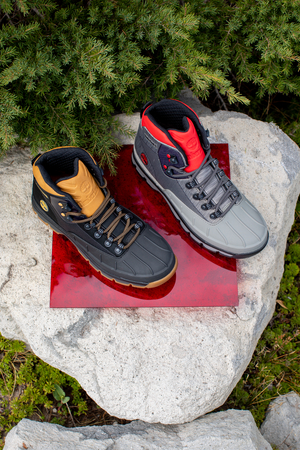A Hiker's Guide to Shoes
A Hiker's Guide to Shoes
 Hiking demands the right boots for your feet and the type of hiking you do. The perfect hiking boots for you depend on how and where you hike. Before choosing a pair of boots, consider the different types of boots available, their components, and fit. Just like other shoes, if your boots don't fit properly, you'll be miserable.
Hiking demands the right boots for your feet and the type of hiking you do. The perfect hiking boots for you depend on how and where you hike. Before choosing a pair of boots, consider the different types of boots available, their components, and fit. Just like other shoes, if your boots don't fit properly, you'll be miserable.
Types of Hiking Boots
- Hiking Shoes: This low-cut footwear is ideal for day-hikers. They have flexible midsoles, and many are ultralight. Some people use these shoes for trail running.
- Day Hiking Boots: This type of shoe can be mid- or high-cut, and they are intended to be worn on day hikes or for short backpacking trips. You won't have to wear them long to break them in, and the soles flex easily. These boots don't have strong support and durability, however.
- Backpacking Boots: These boots are designed for backcountry backpacking trips. They are usually high-cut, giving the ankles more support. The midsoles are moderately stiff, and these boots are ideal for both on and off the trail.
Hiking Boot Components
- The Uppers: Choose from full-grain leather, split-grain leather, nubuck leather, synthetics, waterproof membranes, or vegan, and consider your insulation needs. Full-grain leather is durable and water-resistant but not completely breathable. Split-grain leather may be mixed with nylon, enhancing breathability. Nubuck leather is full-grain leather that resembles suede, so it's durable and water-resistant. Synthetics are made of polyester or nylon, so they are lighter, faster to dry, and less expensive. Waterproof membranes are designed to keep feet dryer, but they don't breathe well. Vegan hiking boots do not contain any animal ingredients or materials. Insulation may be added to some boots for added warmth.
- The Midsoles: The midsole gives cushioning and protects feet from shocks. People hiking for long distances need stiff boots for more comfort and stability. Midsoles may be made of EVA, which is less expensive and lighter, or polyurethane, which is more durable.
- Internal Support: The shanks sit between the midsole and outsole, adding stiffness to the midsole. Plates are inserts that are also between the midsole and outsole, just below the shanks. Plates protect the feet from shocks.
- The Outsoles: Hiking boot outsoles are made of rubber, and they may have carbon added to make them harder. Hard outsoles are durable, but they may be slippery. Lugs are bumps on the outsole, making the sole better at gripping terrain. Heel brakes help make it less likely for slips to happen when going downhill.
- Crampon Compatibility: Those engaging in winter backpacking need to have boots that are compatible with crampons for added safety.
Hiking Boot Fit
Hiking boots need to be snug but not so tight that you can't wiggle your toes freely. After a long day of hiking, feet tend to swell, and you may also want to wear extra-thick socks in your boots. Your hiking boots need to be large enough to accommodate swollen feet and thick socks.
- Sizing: Have your feet measured professionally for length, width, and arch. Double-check the measurements, and then compare your foot length to a boot sizing chart to find your size. Ideally, you should have a thumb-width between your longest toe and the end of the boot insole.
- Trying on Boots: Try on boots and shoes at the end of the day when your feet are bigger. Bring along orthotics to try on boots if you wear them. Always wear the type of socks you'll likely be wearing while hiking when you try on boots. Walk around the store in a pair of boots before you buy them to make sure they're comfortable.
- Other Considerations: If you shop online, stick with a brand of boot that you've worn successfully before. If the boots feel uncomfortable, try a different lacing method or consider adding aftermarket insoles. If firm lacing doesn't fix an extra space above your foot, the boot volume is incorrect for your foot. Don't forget to break boots in before a hiking trip.
Additional Resources
- Five Tips for Choosing Hiking Boots: Understanding the difference between different hiking footwear is the first step to choosing the right hiking boots.
- Gear: Choosing the Right Pair of Hiking Boots: The type of boot you choose will depend on the type of hiking you do and the types of trails you visit.
- How to Choose Hiking Boots: If you visit rough trails, choose ankle-high boots for more support.
- Do I Need Hiking Boots? Hiking boots are designed to protect feet from injuries from rocks and trail debris.
- How to Choose Hiking Boots: Hiking boots need to fit comfortably as well as fit your needs for hiking and walking.
- How to Buy Hiking Boots: While you may be able to buy secondhand camping gear or clothing, you shouldn't buy hiking boots that someone else has already worn.
- How to Choose Hiking Boots: A Really Simple Guide: You'll want a pair of hiking boots that give your feet enough space but don't allow them to slide around.
- Trekking and Alpine Hiking Boots: Alpine boots are designed to be waterproof, somewhat heavy, supportive, and protective.
- How to Best Choose Your Mountain Hiking Boots and Shoes: Mountain shoes need to be rigid, supportive, and waterproof and have a grippy outsole.
- How to Choose Hiking Boots: Day hiking boots are flexible and light in weight and designed for shorter hikes.
- How to Choose Your Hiking Boots: Buy the highest-quality hiking boot you can afford to ensure that your feet are comfortable and safe.
- Mid-Cut vs. Low-Cut vs. High-Ankle Hiking Boots: Having ankle support is very important for hikers who engage in longer-distance hiking.
- Winter Hiking Boot FAQ: Winter boots need to have adequate insulation to keep feet warm, and they need to be waterproof.
- The Backpacker's Guide to Happy Feet: Trail runners are designed to grip uneven trails, and they typically have a heavy tread pattern.
- What Are the Bottoms of Your Shoes Telling You? Examining the soles of a pair of shoes or boots you wear a lot will tell you what type of foot pattern you have, which can help you choose hiking boots.
- Finding the Best Hiking Boots: Expert reviewers break down the top hiking boots on the market right now for a variety of needs.
- Tips and Tricks That Every Park-Goer Should Know: While it may be tempting to hike in running shoes or casual sneakers, hiking boots offer more support and protection.
- Backpacking Clothing: Proper footwear is essential because your feet are impacting the ground with every step during a hike.








